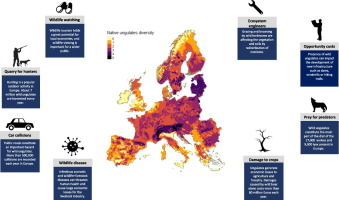当前位置:
X-MOL 学术
›
Biol. Conserv.
›
论文详情
Our official English website, www.x-mol.net, welcomes your
feedback! (Note: you will need to create a separate account there.)
The challenges and opportunities of coexisting with wild ungulates in the human-dominated landscapes of Europe's Anthropocene
Biological Conservation ( IF 4.9 ) Pub Date : 2020-04-01 , DOI: 10.1016/j.biocon.2020.108500 John D.C. Linnell , Benjamin Cretois , Erlend B. Nilsen , Christer M. Rolandsen , Erling J. Solberg , Vebjørn Veiberg , Petra Kaczensky , Bram Van Moorter , Manuela Panzacchi , Geir R. Rauset , Bjørn Kaltenborn
Biological Conservation ( IF 4.9 ) Pub Date : 2020-04-01 , DOI: 10.1016/j.biocon.2020.108500 John D.C. Linnell , Benjamin Cretois , Erlend B. Nilsen , Christer M. Rolandsen , Erling J. Solberg , Vebjørn Veiberg , Petra Kaczensky , Bram Van Moorter , Manuela Panzacchi , Geir R. Rauset , Bjørn Kaltenborn

|
Abstract The cumulative impact of human activities has driven many species into severe declines across the globe. However, the recent focus on conservation optimism has begun to highlight case studies that go against this trend. Reforestation, agricultural abandonment, reintroduction and legislative change have led to a situation where large mammals have recovered and are now widespread across the European continent. This study summarizes the knowledge about wild ungulate distribution in Europe and review the diversity of ways in which they interact with humans. Drawn from a wide range of sources, we built distribution maps of European wild ungulates. Results show that 90% of Europe is home to at least 1 species of wild native ungulate, with roe deer and wild boar occupying 74% and 64% of Europe respectively. In contrast, wild native mountain ungulates only occupy 5% of Europe, and are often associated with protected areas. The wide distribution of most European ungulates combined with the extensive human activity within Europe result in a wide range of interactions between ungulates and humans. These interactions can be classified as services or disservices depending on the value orientation and economic position of the various stakeholders perceiving this relationship. Overall, our survey highlights the success of wildlife management policies in Europe and the potential for continental scale conservation of large mammals in human-dominated landscapes. However, maintaining the success of wild ungulate conservation requires actions from national and European institutions to improve coordinated management across jurisdictional borders and sectorial coordination for the whole landscape.
中文翻译:

在欧洲人类世人类主导的景观中与野生有蹄类动物共存的挑战和机遇
摘要 人类活动的累积影响已导致全球许多物种严重减少。然而,最近对保护乐观主义的关注已经开始突出与这一趋势背道而驰的案例研究。重新造林、农业废弃、重新引入和立法变化导致大型哺乳动物已经恢复并现在遍布整个欧洲大陆。本研究总结了有关欧洲野生有蹄类动物分布的知识,并回顾了它们与人类互动方式的多样性。我们从广泛的来源中提取,构建了欧洲野生有蹄类动物的分布图。结果表明,欧洲 90% 的地区拥有至少 1 种野生本土有蹄类动物,狍和野猪分别占欧洲的 74% 和 64%。相比之下,野生原生山地有蹄类动物仅占欧洲的 5%,并且通常与保护区相关联。大多数欧洲有蹄类动物的广泛分布与欧洲范围内广泛的人类活动相结合,导致有蹄类动物与人类之间存在广泛的相互作用。根据感知这种关系的各种利益相关者的价值取向和经济地位,这些相互作用可以归类为服务或损害。总体而言,我们的调查突出了欧洲野生动物管理政策的成功以及在人类主导的景观中大型哺乳动物在大陆范围内保护的潜力。然而,
更新日期:2020-04-01
中文翻译:

在欧洲人类世人类主导的景观中与野生有蹄类动物共存的挑战和机遇
摘要 人类活动的累积影响已导致全球许多物种严重减少。然而,最近对保护乐观主义的关注已经开始突出与这一趋势背道而驰的案例研究。重新造林、农业废弃、重新引入和立法变化导致大型哺乳动物已经恢复并现在遍布整个欧洲大陆。本研究总结了有关欧洲野生有蹄类动物分布的知识,并回顾了它们与人类互动方式的多样性。我们从广泛的来源中提取,构建了欧洲野生有蹄类动物的分布图。结果表明,欧洲 90% 的地区拥有至少 1 种野生本土有蹄类动物,狍和野猪分别占欧洲的 74% 和 64%。相比之下,野生原生山地有蹄类动物仅占欧洲的 5%,并且通常与保护区相关联。大多数欧洲有蹄类动物的广泛分布与欧洲范围内广泛的人类活动相结合,导致有蹄类动物与人类之间存在广泛的相互作用。根据感知这种关系的各种利益相关者的价值取向和经济地位,这些相互作用可以归类为服务或损害。总体而言,我们的调查突出了欧洲野生动物管理政策的成功以及在人类主导的景观中大型哺乳动物在大陆范围内保护的潜力。然而,











































 京公网安备 11010802027423号
京公网安备 11010802027423号